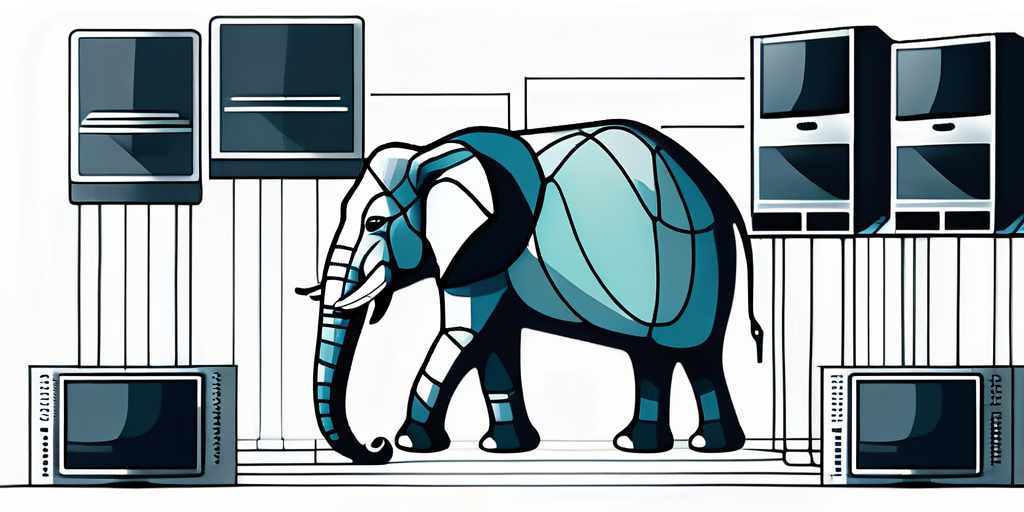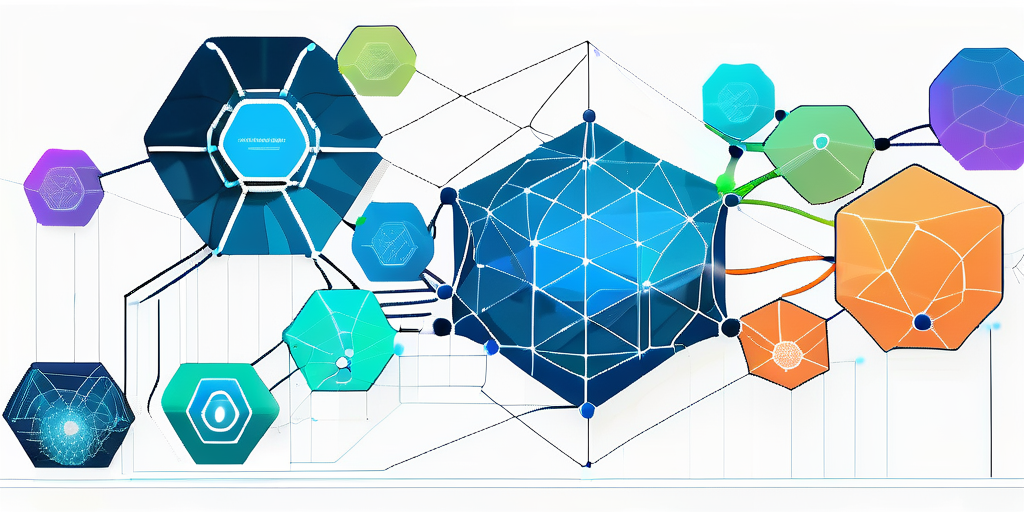
Hadoop is a powerful and widely-used framework in the world of big data. Understanding its basics is essential for anyone working with large datasets. In this article, we will explore the definition, core components, architecture, working mechanism, advantages, and future trends of the Hadoop framework.
Understanding the Basics of Hadoop Framework
Definition of Hadoop Framework
At its core, Hadoop is an open-source software framework that facilitates the distributed processing of large datasets across clusters of computers. It was designed to handle big data challenges, such as storage, scalability, and fault tolerance, by leveraging commodity hardware.
Core Components
The Hadoop framework consists of three primary components:
- Hadoop Distributed File System (HDFS): HDFS is a distributed file system that stores data across a cluster of machines. It provides high reliability, fault tolerance, and the ability to handle large data sets by dividing them into smaller blocks and distributing them over different nodes.
- MapReduce: MapReduce is the processing engine of Hadoop, responsible for parallelizing and executing data processing tasks across the cluster. It divides the input data into smaller chunks, applies operations in a distributed manner, and then combines the results.
- YARN (Yet Another Resource Negotiator): YARN acts as a resource management layer in Hadoop, responsible for managing cluster resources and scheduling jobs. It enables multiple data processing engines to run on top of Hadoop, making it a versatile and flexible framework.
The Importance in Big Data
Hadoop has emerged as a game-changer in the world of big data due to its numerous benefits. It allows organizations to store, process, and analyze massive volumes of structured and unstructured data efficiently. The ability to process data in parallel across multiple machines enables faster insights and decision-making, leading to improved business outcomes.
The cost-effectiveness of commodity hardware and the fault tolerance offered by Hadoop make it an attractive option for many organizations. Its scalability allows businesses to expand their data infrastructure as their needs grow, ensuring they can harness the full potential of big data.
Furthermore, Hadoop’s versatility extends beyond its core components. It offers a rich ecosystem of tools and technologies that enhance its capabilities and make it even more powerful. For example, Apache Hive provides a SQL-like interface to query and analyze data stored in Hadoop, making it accessible to users familiar with traditional relational databases.
In addition, Apache Spark, a fast and general-purpose cluster computing system, can be seamlessly integrated with Hadoop. Spark enables real-time data processing, machine learning, and graph processing, further expanding the range of applications that can be built on top of the Hadoop framework.
Moreover, Hadoop’s open-source nature fosters innovation and collaboration. A vibrant community of developers and contributors continuously work on improving and extending the capabilities of Hadoop, ensuring that it remains at the forefront of big data processing technologies.
The Architecture of Hadoop Framework
Overview of Architecture
The Hadoop architecture follows a master-slave design, where one node acts as the master and coordinates the overall functioning of the cluster, while the rest of the nodes serve as slaves and perform data processing tasks.

The master node contains the NameNode, responsible for managing file system operations and metadata, and the JobTracker, responsible for coordinating the MapReduce tasks. The slave nodes contain the DataNodes, responsible for storing and processing data, and the TaskTrackers, responsible for executing MapReduce tasks.
Let’s dive deeper into the key components of the Hadoop architecture:
- NameNode: The NameNode is the central point of control in Hadoop. It manages the file system namespace and regulates access to files by clients. It keeps track of the metadata, such as file names, permissions, and the location of data blocks.
- DataNode: DataNodes are responsible for storing and processing data in Hadoop. They receive instructions from the NameNode and perform read and write operations on the data blocks. DataNodes also handle data replication to ensure fault tolerance.
- JobTracker: The JobTracker is responsible for coordinating the MapReduce tasks in Hadoop. It receives job requests from clients, breaks them into smaller tasks, and assigns them to TaskTrackers for execution. The JobTracker monitors the progress of tasks and handles task failures or reassignments.
- TaskTracker: TaskTrackers are responsible for executing MapReduce tasks assigned by the JobTracker. They receive the task code and data from the JobTracker and perform the required computations. TaskTrackers report the task status back to the JobTracker, enabling it to track the overall progress of the job.
Key Features of Architecture
The architecture of Hadoop offers several key features:
- Distributed Computing: Hadoop allows the distribution of data and computations across multiple machines, enabling parallel processing and faster performance. This distributed nature of Hadoop makes it ideal for handling big data workloads.
- Scalability: Hadoop can scale horizontally by adding more machines to the cluster, accommodating the growing data requirements of organizations. As the data volume increases, Hadoop can seamlessly add more nodes to handle the load, ensuring efficient processing.
- Fault Tolerance: Hadoop can tolerate failures in individual nodes by replicating data across multiple nodes, ensuring that data remains accessible even in the presence of hardware or software failures. If a node fails, Hadoop automatically redirects the tasks to other available nodes, maintaining uninterrupted processing.
- Data Locality: Hadoop optimizes data processing by moving computations closer to the data, minimizing network congestion and reducing data transfer time. By processing data locally, Hadoop reduces the need for data movement across the network, resulting in faster processing and improved performance.
Understanding Hadoop Distributed File System (HDFS)
HDFS is one of the core components of Hadoop and provides a reliable and scalable storage layer for big data sets. It breaks down large files into blocks and distributes them across different nodes in the cluster. This distributed storage approach ensures that no single node becomes a bottleneck for data access.
HDFS offers fault tolerance by creating replicas of each block on multiple nodes. If a node fails, HDFS can retrieve the data from other replicas, ensuring data availability and reliability. This replication mechanism also enhances data durability, as it protects against data loss due to hardware failures.
HDFS is highly optimized for sequential data access, making it suitable for batch processing and streaming workloads. It efficiently handles the storage and retrieval of massive datasets, making them available for analysis by the distributed processing engines. With HDFS, organizations can store and process large volumes of data without worrying about storage limitations or performance bottlenecks.
Working Mechanism of Hadoop Framework

Data Processing in Hadoop
Hadoop processes data through its MapReduce paradigm. MapReduce divides the data processing job into two phases: the map phase and the reduce phase.
In the map phase, data is read from the input source, and a mapping function is applied to generate intermediate key-value pairs. The intermediate results are then shuffled and sorted to group similar keys together.
In the reduce phase, the sorted intermediate data is processed to produce the final output. The reduce function applies the required operations on the grouped data and generates the desired result.
MapReduce in Hadoop
MapReduce is a programming model and processing framework that allows distributed processing and analysis of large datasets. It abstracts the complex task of parallelizing computations over a cluster of machines, making it easier for developers to write scalable and fault-tolerant data processing applications.
The MapReduce model is based on key-value pairs, allowing developers to define custom map and reduce functions according to their specific data processing requirements. The framework takes care of task distribution, fault tolerance, and data locality, enabling efficient and reliable data processing.
YARN: Yet Another Resource Negotiator
YARN is an essential component of the Hadoop ecosystem that centralizes and manages cluster resources. It enables multiple data processing engines, such as MapReduce and Apache Spark, to coexist on the same Hadoop cluster.
YARN provides an efficient resource allocation and scheduling mechanism, ensuring fair distribution of resources among different applications running on the cluster. It allows organizations to leverage different data processing frameworks based on their specific needs, expanding the capabilities of the Hadoop ecosystem.
Furthermore, YARN offers a flexible and scalable architecture that can handle a wide range of workloads. It supports multi-tenancy, allowing multiple users and applications to share the same cluster while maintaining isolation and security. This enables organizations to maximize the utilization of their Hadoop infrastructure and achieve better cost efficiency.
In addition, YARN provides a pluggable architecture that allows for the integration of new data processing engines and frameworks. This means that as new technologies and tools emerge in the big data landscape, they can easily be integrated into the Hadoop ecosystem without disrupting existing applications and workflows.
Moreover, YARN offers advanced features such as dynamic resource allocation and fine-grained resource management. It can dynamically adjust resource allocations based on application requirements and cluster availability, ensuring optimal performance and resource utilization. This flexibility allows organizations to efficiently handle varying workloads and scale their data processing capabilities as needed.
In conclusion, the Hadoop framework, with its MapReduce paradigm and the support of YARN, provides a powerful and versatile platform for processing and analyzing large datasets. It simplifies the development of scalable and fault-tolerant data processing applications, while offering flexibility and scalability to meet the diverse needs of organizations in the big data era.
Advantages and Disadvantages of Hadoop Framework
Benefits of Using Hadoop Framework
The Hadoop framework offers several advantages:

- Cost-Effective: Hadoop is based on commodity hardware, reducing infrastructure costs compared to traditional storage and processing solutions.
- Scalability: Hadoop can scale horizontally, allowing organizations to accommodate expanding data volumes without significant added costs.
- Fault Tolerance: By replicating data across multiple nodes, Hadoop ensures high availability and fault tolerance, minimizing the impact of node failures.
- Processing Speed: The distributed nature of Hadoop enables faster data processing and analysis, accelerating insights and decision-making.
One of the key advantages of the framework is its ability to handle big data. With the exponential growth of data in recent years, traditional storage and processing solutions have struggled to keep up. Hadoop, on the other hand, is designed to efficiently store and process large volumes of data. Its distributed file system, known as Hadoop Distributed File System (HDFS), allows for the storage and retrieval of data across multiple machines, enabling parallel processing and faster data analysis.
In addition to its scalability and processing speed, Hadoop also offers cost-effective solutions for organizations. By utilizing commodity hardware, which is less expensive compared to specialized hardware, organizations can significantly reduce their infrastructure costs. This makes Hadoop an attractive option for businesses of all sizes, as it provides a cost-effective way to store and process large amounts of data.
Limitations
While Hadoop has numerous benefits, it also has certain limitations:
- Complexity: Hadoop has a steep learning curve and requires expertise to set up and manage the cluster properly.
- Real-Time Processing: Hadoop’s batch processing nature makes it less suitable for real-time or interactive analytics scenarios where immediate feedback is required.
- Data Security: Hadoop doesn’t inherently provide fine-grained access controls and data encryption, requiring additional security measures to protect sensitive data.
One of the main limitations of Hadoop is its complexity. Setting up and managing a Hadoop cluster requires specialized knowledge and expertise. Organizations need to invest time and resources in training their staff or hiring professionals who are well-versed in Hadoop. Additionally, the complexity of Hadoop can make troubleshooting and debugging more challenging, potentially leading to delays in data processing and analysis.
Another limitation of Hadoop is its suitability for real-time processing. While Hadoop excels at processing large volumes of data, it is not designed for real-time or interactive analytics scenarios where immediate feedback is required. Hadoop’s batch processing nature means that data is processed in batches, which can introduce delays in obtaining insights from the data. For applications that require real-time analytics, alternative solutions may need to be considered.
Lastly, it’s data security capabilities may not be sufficient for organizations with stringent security requirements. While it provides basic security features, such as authentication and authorization, it doesn’t inherently offer fine-grained access controls and data encryption. Organizations that deal with sensitive data may need to implement additional security measures, such as encryption at rest and in transit, to ensure the confidentiality and integrity of their data.
Future Trends in Hadoop Framework
Hadoop and Cloud Computing
Hadoop is increasingly being integrated with cloud computing platforms, leveraging their scalability and flexibility. Cloud-based solutions, such as Amazon EMR and Google Dataproc, simplify the deployment and management of clusters, making it more accessible to organizations of all sizes.

Cloud integration allows businesses to reap the benefits of Hadoop without the upfront infrastructure costs and maintenance overhead. It enables seamless scaling and elastic resource provisioning, making it easier to handle dynamic workloads and optimize costs.
Machine Learning
Hadoop’s ability to process large datasets in parallel has made it a popular platform for big data analytics and machine learning. It provides the needed infrastructure to build and train complex machine learning models on huge volumes of data.
Machine learning libraries, such as Apache Spark MLlib and Mahout, integrate with, enabling efficient distributed training and inference. By leveraging this for machine learning workloads, organizations can unlock actionable insights and make data-driven decisions.
The Role in Internet of Things (IoT)
The proliferation of IoT devices has resulted in an explosion of data volume and variety. Hadoop plays a crucial role in managing and analyzing this vast amount of IoT-generated data.
With Hadoop, organizations can ingest, store, and process IoT data, enabling them to derive valuable insights and make informed decisions. The combination of Hadoop’s scalability, data processing power, and fault tolerance makes it an ideal foundation for IoT analytics applications, driving innovations in various industries.In conclusion, the Hadoop framework is a vital tool for handling big data challenges. Its ability to efficiently store, process, and analyze large datasets has revolutionized the way organizations approach data-driven decision-making. Understanding the basics, architecture, working mechanism, advantages, and future trends of Hadoop is essential for anyone venturing into the world of big data.